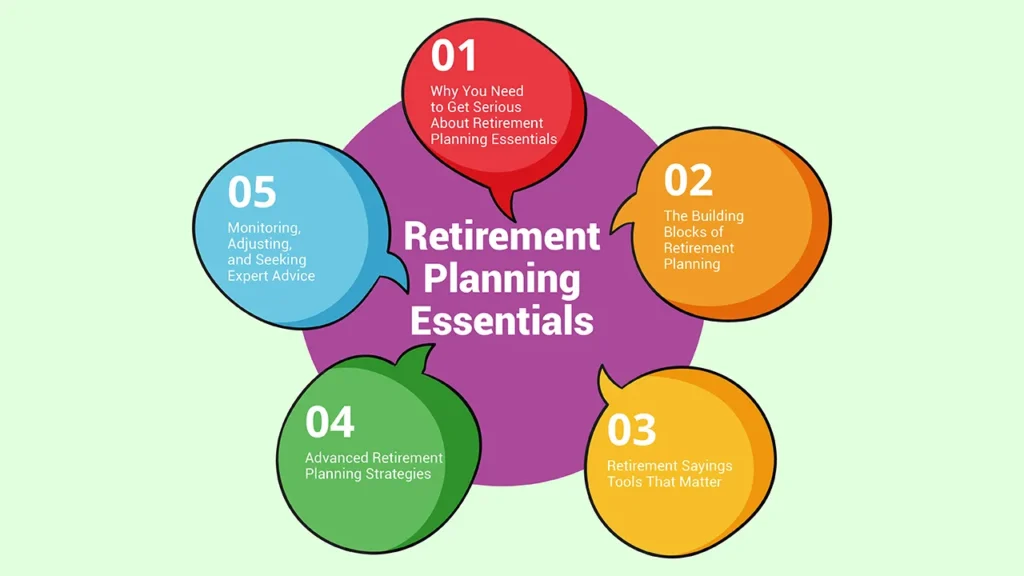Although retirement is an exciting time, it can also be quite confusing. Many are concerned not about whether they’ll have enough money but how to pay expenses like health care and everyday living without a paycheck coming in, and if they have saved enough.
The good news is that you can prepare for a financially secure future by using the retirement planning essentials. When you know important steps to take, such as goal setting, reviewing your current financial state, selecting the most suitable savings plans, and investing wisely, you can grow confidence in anticipation of the years to come.
Whether you’re getting a head start on retirement or scrambling to catch up, the main actions you can take to ensure a stress-free and comfortable retirement are outlined in this plan.

Section 1: Why You Need to Get Serious About Retirement Planning Essentials
1. The Need to Plan for Your Retirement
People are living longer, so your savings must last for many years. Inflation erodes the purchasing power of your money over time, and health care costs tend to increase as you get older. With your main source of income ceasing, replacing that income so that you can maintain your chosen lifestyle is paramount. For a general overview, refer to the U.S. Department of Labor’s “Preparing for Retirement”.
2. Dispelling Common Retirement Myths
Getting a late start on retirement planning also shrinks the potential price of compounding interest, making the job of socking away as much as you should save a more difficult one.
Some think their pensions or government benefits will be enough, but that frequently only pays for the barest essentials. Finally, for health or other reasons, people won’t always be able to work longer.
Section 2: The Building Blocks of Retirement Planning
Pillar 1: Define Your Retirement Vision and Goals
Consider what you want to do for retirement. Will you travel, take up hobbies, or work part-time? Choose your desired retirement date, decide approximately how much money you will need for future expenses (housing, food, health care, and a little fun), and then adjust for inflation.
Pillar 2: Assess Your Current Financial Health
Determine your net worth by subtracting your debts from your assets, such as savings, investments, and property. Review your income and expenses to determine how much you can save each month. High-interest debt and an emergency fund are equally important to protect you from financial shocks.
Section 3: Retirement Sayings Tools That Matter (Universal Truths)
1. Breaking Down Your Tax-Free Retirement Account
In many countries, tax-advantaged savings plans are provided for retirement. These include workplace retirement plans (such as 401(k)s), individual retirement accounts, and government pensions. Such accounts incentivize saving by cutting taxes today or in retirement.
2. The Potential of Diversified Investment
Diversify your money among stocks, bonds, real estate and other options that correspond with your risk comfort level and retirement horizon. This mix provides a combination of growth and a dependable income stream as you near retirement.
Section 4: Advanced Retirement Planning Strategies
1. Compound Interest: Begin Early and Save Regularly
When you save early, your money has more time to grow exponentially: the longer your money is invested, the more time it can compound and take full advantage of compound interest.
Regular investing through an approach known as dollar-cost averaging mitigates risk by purchasing at market highs and lows.
2. Managing Risk in Retirement Planning
To protect yourself from inflation, consider storing your wealth in assets that generally increase in value at a rate faster than rising prices. Diversify your investments to reduce market risk, and you might want to think about annuitizing or using a safe withdrawal rate to lessen the risk of outliving your savings. Additionally, prepare for healthcare costs by utilizing focused savings accounts or insurance.
3. Considering Annuities and Other Income Streams
Combined, they offer guaranteed income payments – immediately or to be deferred – to help anchor your retirement finances. You can add part-time or rental income from properties to help supplement your household budget.
Section 5: Monitoring, Adjusting, and Seeking Expert Advice
1. Annual Review and Rebalancing
Review your retirement goals and savings plan at least yearly and make the necessary changes to your investment portfolio to ensure a good balance of investments to meet your target asset allocation as you get older. Significant life changes, such as getting married or losing a job, may also call for plan updates.
2. When to Hire a Financial Adviser
If you follow their advice, financial advisors offer independent, expert advice specific to your situation. Selecting an advisor (if engaged) with the proper credentials and preferably fee-only, e.g., CFP or a CFA, can add a lot of value to your retirement plan.
Conclusion: The Power to Achieve Your Retirement Goals
Planning for retirement is a lifelong process that includes specific goals, evaluating your financial situation, leveraging saving tools to your advantage, utilizing investment options to your advantage, and managing over time.
With the so-called retirement planning fundamentals, you can happily secure your financial planning. The sooner you start, the better; small, disciplined steps lead to a comfortable, worry-free retirement.
FAQs
1. Why do I need to plan for retirement?
To make sure you have enough money to keep the lifestyle you’re accustomed to, pay for health care, and manage inflation when you stop working.
2. Can I start retirement planning late?
You do, but the earlier you start, the sooner compounding has time to work its spell, and the less pressure you have to save huge sums later.
3. What types of retirement accounts should I consider?
Invest in tax-advantaged accounts in your country, such as employer-sponsored plans (401(k)), IRAs, and government fallback pensions.
How can I manage risk as I approach retirement?
Diversify your investments, add protection from inflation, and don’t overlook guaranteed sources of income, such as annuities.
When do I need a financial adviser?
Your finances are complicated, or you want customized guidance when building or optimizing your retirement plan.

Leave a Reply